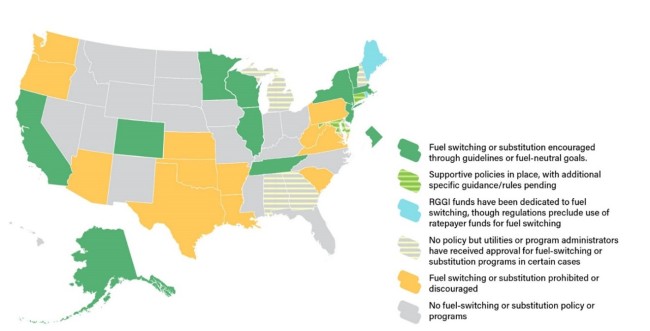A small but growing number of states are enabling utilities to offer incentives for customers to switch from fossil fuel heating to electric heat pumps. Yet almost half of states have not implemented fuel-switching programs to reduce greenhouse gas (GHG) emissions from home heating.
As many states have strengthened their climate goals in recent years, policymakers are working with regulators and utilities to reshape energy efficiency programs to support efforts to eliminate statewide GHG emissions by mid-century. This has meant reexamining and updating efficiency policy frameworks that traditionally have encouraged reducing electricity or gas usage but have not promoted the transition to heating with efficient electric heat pumps. Traditional policies fail to deliver additional economic, health, and climate benefits achieved through beneficial electrification. Because burning fossil fuels in buildings accounts for 13% of total U.S. emissions, accelerating the electrification of these end uses is critical for meeting climate goals.
A new policy brief from the American Council for an Energy-Efficient Economy (ACEEE) shows a changing landscape of utility energy efficiency policies with new fuel-switching incentive structures emerging in key states. Our last look at these policies, in 2020, saw limited adoption of electrification incentive structures, mostly limited to northeastern states like New York, Massachusetts, and Maine. The new report shows similar efforts in other parts of the country.
Three major clean energy laws that passed in 2021 have moved the ball forward: Minnesota’s Energy Conservation and Optimization (ECO) Act, Illinois’s Climate and Equitable Jobs Act, and Colorado’s beneficial electrification law. Each directs regulators to update efficiency policies to encourage electrification through increased customer incentives. These new laws are helping lay the foundation for utility reforms that will make adoption of heat pump technologies more affordable for millions of customers.
Despite the progress made in some states, many states do not encourage energy-efficient fuel switching, with at least 12 states explicitly prohibiting or discouraging use of efficiency funds for fuel switching, posing a barrier to accelerating heat pump deployment.
Our new policy brief provides a status update of these policies (or lack thereof) in all 50 states and Washington, DC, including summaries and links to relevant legislation, utility rulemakings, and guidance documents addressing these efforts. We recommend that states that have not yet enacted these reforms follow examples of leading peers and:
Enact laws directing utilities to develop beneficial electrification programs. In Colorado, new utility electrification programs must include targeted numbers of installations and projected GHG emissions reductions. In Massachusetts, climate legislation passed in 2021 significantly reframed utility energy efficiency plans around a focus on building decarbonization through weatherization and efficient electrification, including benchmarks for air-source and ground-source heat pumps.
Clarify that state efficiency programs can fund electrification that results in net energy and emissions savings. This can help make clear that efficiency funds are eligible to be used for measures resulting in net GHG reductions from efficient fuel-switching measures like electrification. For example, Minnesota’s ECO Act expanded the scope of measures to be funded by the state’s Conservation Improvement Program to allow fuel-switching measures if such measures result in a net decrease in source energy consumption on a fuel-neutral basis. In March 2022, the state Department of Commerce issued technical guidance for utilities to determine if a fuel-switching improvement meets these criteria and to calculate energy savings associated with such an improvement.
Adopt an energy efficiency resource standard that aligns energy-saving programs with efforts to reduce GHG emissions. Adopting a multi-fuel metric measured in British thermal units (Btu) from such measures, and ultimately encourage heat pump adoption, New York has established a fuel-neutral 2025 energy efficiency target of 185 trillion Btu including a minimum Btu heat pump savings target. In Massachusetts, to support the state’s 2030 economy-wide emissions reduction target set in the 2021 law, the state has established GHG savings goals for efficiency programs for the 2022-24 period. The Mass Save program has established a scorecard for annual metric tons of carbon dioxide equivalent avoided by efforts undertaken during the 2022-24 period.
Fully value the energy and climate benefits of beneficial electrification in program planning and evaluation. Cost-effectiveness tests that neglect the full range of societal and customer benefits of fuel-switching programs can also slow heat pump adoption. Several states have taken steps to refine calculations of energy and carbon savings and other benefits to better understand impacts on customer costs, emissions, and the utility system. Colorado’s new law specifies the cost-benefit analysis requirements for new electrification programs, including incorporating the social costs of carbon dioxide and methane emissions avoided from converting from gas systems to electric heat pumps. Other states are conducting studies and pilot programs to determine customer incentive levels and refine cost-effectiveness. New Jersey is studying payback periods for electrification and on-site electric generation measures with the aim of incorporating cost-effective measures into building and energy codes.
Integrate equity principles to ensure program benefits extend to historically underserved customers. Low-income and underserved communities already bear a disproportionate share of high energy burdens and the impacts of climate change. For the clean energy transition to succeed on a broad scale, it must benefit all communities, not just affluent ones. Several states have established specific requirements prioritizing the low-income sector. In Illinois, a minimum of 25% of all electrification savings must be from electrification of end uses in low-income housing. New electrification plans in Colorado direct at least 20% of funding toward low-income and disproportionately impacted communities and include an outreach plan for engaging those communities.
As states look to meet their mid-century climate goals, the progress in Colorado, Illinois, Minnesota, and states in the Northeast can help guide policymakers on how to enable efficiency programs that encourage electrification as a means to reduce GHG emissions.




